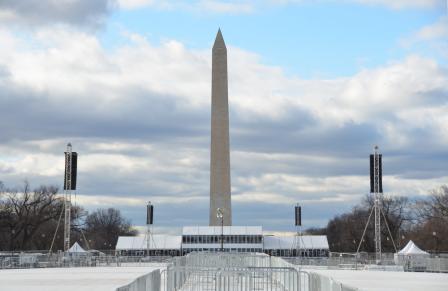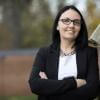How Do You Estimate Crowd Size?
The recent controversies surrounding the Inauguration and the Women’s March on Washington may have you asking: how do you accurately estimate the size of a crowd?
With the inauguration of the 45th president of the United States this past weekend and the dissenting marches that followed, there’s one type of science that is dominating the news cycle, and that’s crowd science, or the science behind estimating the number of people in a large crowd. Crowd scientists can have a range of expertise, including census work, remote sensing, geospatial analysis, and even cartography, all of which can help with the daunting task of crowd counting.
Some reports quoted the inaugural attendance as low as 250,000 people, but the president himself said “it looked like a million, a million and a half people.” Twenty-four hours later, estimates for attendees of the Women’s March on Washington were consistently larger, although they ranged from 500,000 to 1 million people. So who is right? How do crowd scientists estimate the number of people at these large events and why don’t they agree?
What Methods Are Used for Crowd Counting?
The most common method for estimating the number of people in a large crowd, known as Jacobs Method, is actually pretty straightforward. The technique is named after Herbert Jacobs, a professor of journalism at UC Berkeley who came up with it while trying to estimate the size of the Vietnam War protests outside his office window in the 1960s.
Jacobs noticed that the ground outside was gridded so he could carefully count how many protesters were in one square on the grid and then multiply by the number of squares. Thus crowds in spaces like the National Mall that are laid out in a natural grid-like pattern can be easier to tally.
If a rally space is not so conveniently gridded, knowing the total area, along with the density of the crowd, is also sufficient. The most tightly packed crowd, known officially as “mosh pit density,” has one person per every 2.5 square feet. This is the sort of crowd where, if you were able to pick your feet up off the ground, you’d be so squished by those around you that you’d probably stay upright just fine. This density of people is considered a strict upper limit—any crowd counts that allot less space per person are not considered physically possible.
A more breathable crowd puts one person per ever 4.5 square feet which still places you elbow to elbow with your neighbors. A light crowd might have one person per every 10 square feet. Thus breaking up the landscape into higher vs lower crowd density chunks and then multiplying by their relative areas can give very estimates of crowd size usually within 10-20%.
Why Is Crowd Counting So Challenging?
Although the Jacobs Method is fairly simple in principle, the choices made in the execution can lead to varying estimates. Estimations of where the boundaries are for high versus low density spots in the crowd, as well as just how densely packed that crowd is, can vary somewhat with different counts. For very large crowds, the boundaries can be difficult to estimate, or in other words, where rally goers stop and non-attendees begin. The most accurate estimates tend to come from a combination of multi-directional aerial photography, either from satellites, helicopters or balloons showing the expanse of the crowd along with photos taken from the ground showing the density of people from up close.
Some of these complications can be addressed by sophisticated computer algorithms that factor in details like sloped lawns that can give the illusion of more people than are actually present. Thanks to databases like Google Earth, such changes in terrain are fairly well-mapped and thus can be properly taken into account.
Such algorithms can also predict where crowds will be denser, like near Jumbotron screens and closer to central stages. In the winter, rally attendees tend to crowd in areas buffered from the wind, while in the summer, they cluster together in the shade.
Another more meticulous method involves the painstaking task of individually counting attendees either in total or in smaller, representative chunks to by multiplied. Amazon’s Mechanical Turk, for example, essentially provides a database of computer savvy users willing to work for a fee. Multiple counts can be made from aerial images and then averaged, throwing out any outliers.
Another method for crowd estimation that doesn’t rely on aerial photography involves placing counters on the ground who note every person that passes a certain checkpoint. This method can help with moving crowds like marches but also assumes every attendee will pass through a certain location. Sometimes crowd counters can look to how much trash was accumulated or how many port-a-potties were used.
Crowd estimators examining events in city centers like Washington, D.C. can also look at the number of Metro trips taken as a way of making a ballpark estimate. For example, the DC Metro reported that 570,557 trips were taken for the presidential inauguration event on Friday, while over a million riders showed up to Metro stations the next day on Saturday. Of course, not all attendees will take the Metro, and not everyone on the Metro was associated with the event, and so these numbers can really only serve as relative estimates.
The biggest obstacle to getting an accurate estimate of crowd size, however, appears to be who is doing the counting.
Organizers of any political rally, protest, or event will always have motivation to boost their numbers, just as anyone trying to downplay the importance of an event will benefit from underestimating participation.
For example, organizers of the Million Man March in DC in 1995 disagreed with the National Park Service attendance estimate of 400,000 people so strongly that they threatened to sue. Since then, the National Park Service has been banned by Congress from using tax payer dollars to estimate crowd sizes. Other estimates put the crowd at the Million Man March at over 800,000 people. Even if the lowest estimates are true, 400,000 people was still 1.2% of the African American population in the U.S. at the time—an incredibly impressive showing.
As is often the case in science, when an exact count is difficult, it is best to take the average of multiple measurements.
Which Crowd Estimates Should You Believe?
Counts vary as far as the recent events of the inauguration and the resistance marches the following day. The viewing angle from the inaugural dais is also known to obscure gaps in the crowd giving the appearance of a larger attendance than the real count. Thus overhead pictures of the crowd are far more accurate. However, airspace is closed during the inauguration, meaning there are only a few official aerial photographs to work with.
As is often the case in science, when an exact count is difficult, it is best to take the average of multiple measurements. Marcel Altenburg and Keith Still, two crowd scientists from the Manchester Metropolitan University in Britain, tallied the attendees at the inauguration and came up with a similar estimate to that from Steve Doig, a census expert from Arizona State University: three times more people attended the Womens March on Saturday as attended the inauguration on Friday.
The Digital Design and Imaging Service, a Virginia-based company, plans to estimate the number of attendees at the Womens March on Washington and claims they can determine a count with an accuracy of 10%. They employed a tethered aerostat, a fancy name for a weather balloon that is tied down, with a nine-lens camera allowing for a 360 degree view of the crowd. They are working to count individual heads in every photograph which may prove the most accurate way to count the numerous children on shoulders, tree climbers, and people in wheel chairs, that otherwise might get lost in rougher estimates. Their results are still pending.
Until next time, this is Sabrina Stierwalt with Ask Science’s Quick and Dirty Tips for helping you make sense of science. You can become a fan of Ask Science on Facebook or follow me on Twitter, where I’m @QDTeinstein. If you have a question that you’d like to see on a future episode, send me an email at everydayeinstein@quickanddirtytips.comcreate new email.
Image courtesy of shutterstock.







